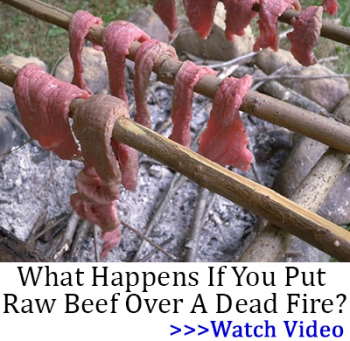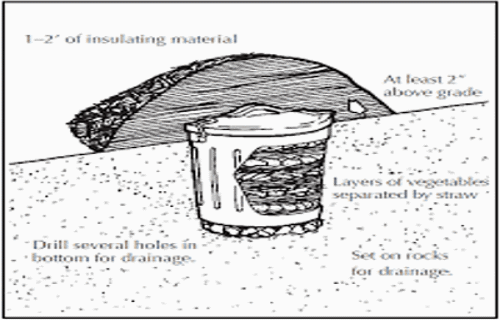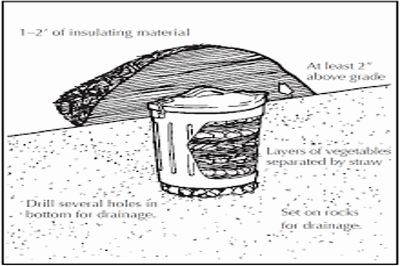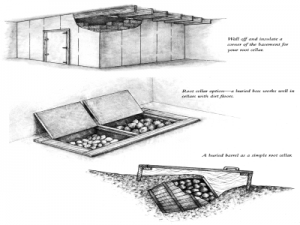Storing Vegetables and Fruits at Home
Many vegetables and fruits can be stored in pits, cellars or basements without refrigeration during cool fall and cold winter months. Successful storage, however, depends on providing the right temperature, humidity, and ventilation.
Outdoor Storage
Produce that requires cool-to-cold moist surroundings can be stored outdoors. All outdoor storage has the disadvantage of being unaccessible sometimes and subject to damage by rodents and other vermin. A well-drained location is essential to prevent excessive accumulation of water.
Usually the produce must be insulated for protection from frost and fluctuating temperatures. Insulating materials commonly used are straw, hay, dry leaves, corn stalks, or wood shavings, and some soil.
Be sure that the insulating materials used are not contaminated with pesticides. In-Garden Storage
It is possible to leave some root crops, such as carrots, turnips, and parsnips in the garden where they grew, for part or all of the winter. (See fig. 1.) After the ground begins to freeze in the late fall, cover the root crops with a foot or more of mulch-straw, hay, or dry leaves. Do not place mulch on warm soil because doing so will cause vegetables to decay rapidly. Wait until the ground is cold.
Produce can be difficult to dig out of the frozenground, but it will not be adversely affected until the
temperature around the roots drops to 25˚F or less.
Carrots are damaged at about 25˚F, but parsnips can stand somewhat lower temperatures.
If rodents are a problem, it may be wise to store produce in a buried container or an indoor storage
area. One gopher can consume a whole row of carrots left in the ground.
Parsnips, horseradish, and turnips actually improve in flavor by light freezing. At temperatures between 28˚F and 34˚F, the starch changes to sugar.
Other crops, such as beets, cabbage, Chinese cabbage,cauliflower, celery, endive, cos or romaine lettuce, kale, leeks, and onions can withstand the early light frosts and can be stored for several weeks under a heavy mulch.
Mounds, Pits
Mounds or pits are a very economical way to store cabbage and root crops, such as carrots, beets, celeriac,kohlrabi, rutabagas, turnips, and winter radishes. (See fig. 2.)
Figure 2. Mound storage
Select a well-drained location, and cover the ground with an insulating mulch. Making a shallow excavation (from 6 to 10 inches deep) and placing the produce partly below the surface will ensure better frost protection, but it will also increase the danger of excess water. Place mulch over vegetables. A ditch around the storage perimeter will help remove surface water. Vegetables keep very well in pits and mounds, but once these storage areas are opened all the produce should be removed. After it’s removed, the produce will keep for 1 or 2 weeks at most. It does not keep as long after removal from storage as will freshly harvested produce.
Root crops can be mixed, but should be separated with mulch to prevent cross-transfer of odors. (See “Separating Fruits and Vegetables,” ahead.)
Buried Containers
A 20-gallon trash can, buried in the ground, makes a convenient and economical storage for many kinds of vegetables. Metal cans are more rodent proof than plastic. (See fig. 3.)
Several holes should be made in the bottom to facilitate drainage. The container must be free of substances that might give off-flavor to the produce. Never use drums or containers that might have held pesticides or other chemicals.
An insulated box or other container can be buried in a well-drained area. Buried containers are more easily opened and closed than mounds and trenches.
This type of storage could be located in a breezeway, shed, or garage for easier access and greater frost protection.
However, if you plan to store food in or near a garage, you must more carefully wrap and protect the produce from car fumes, which produce easily picks up. (See fig. 4.)
Figure 3. Buried trash can storage.
Figure 4. Buried insulated box storage.
Indoor Storage Area
There are many areas in dwellings that naturally provide, or can be adapted to provide a variety of temperature and moisture conditions for storage. These include the attic, unheated rooms, the basement, or cellar. (See fig. 5)
Assess your own storage possibilities. Use a thermometer to monitor temperatures. Any spot that is sufficiently and evenly cool (32˚F–60˚F) can be adapted for some type of food storage. The relative humidity of these locations will also affect what type of produce can be stored.
Even basement window wells can be converted to small storage areas. They can provide cool, moderately moist conditions and can be used to store some types of apples or a variety of root crops. But be sure to separate the produce properly. (See “Separating Fruits and Vegetables,” ahead.) Insulate produce with bales of hay or straw.
A pantry or unheated room is useful for short-term storage of potatoes and onions, and long-term storage of spices, vegetable oils, nuts, and commercially canned goods. Low storage temperatures extend the shelf life of dried foods, such as dried beans, herbs, dried fruits and vegetables, and the life of other products, such as coffee, flour, rice, pasta, and cereals.
Use containers with tight-fitting lids to keep humidity low and rodents and insects out. Guard against freezing when storing in unheated areas.
A warm storage area, such as an attic, can be a good environment in the fall for drying herbs, beans, walnuts, or hickory nuts.
Basement
A well-ventilated basement with central heating is generally dry and has a temperature range of 50˚F to 60˚F. It may be used for ripening tomatoes and for short-term storage of pumpkins, winter squash, potatoes, sweet potatoes, and onions.
If you will be storing only a small amount of produce, an old refrigerator placed in one corner of the basement may be an excellent investment. It can be used for storing head lettuce, cauliflower or cabbage, or apples.
Basement Storage Room
For long-term storage over winter you will need to partition off a room and insulate it to control temperature and moisture.
Build a storage room on the north or east side of the basement, if practicable, and make sure there are no heating ducts or pipes running through it. You will need at least one window for cooling and ventilating the room. Two or more windows are desirable, particularly if the room is divided for separate storage of fruits and vegetables.
Info about building and managing your root cellar, plus printable plans. The book on building and using root cellars – The Complete Root Cellar Book.
A room 4 x 4 x 6 feet is large enough for most households. An area 6 x 7 x 7 feet will hold approximateIy 30 bushels of produce—5 bushels per month for 6 months. An area 8 x 10 x 7 feet will hold approximately 60 bushels of produce—10 bushels per month for 6 months. (See fig. 6)
To deter rodents, carefully install sheathings or screens on the partition walls so there are no openings at the floor or ceiling. Young mice can crawl through a quarter-inch hole. (See fig. 7)
Figure 6. Basement storage.
Figure 7. Basement storage ventilation system.
Managing a Storage Area
Regulating the Temperature
Proper temperatures are critical to long-term storageof vegetables and fruits. Improper temperatures,
whether too cool or too warm, can cause rapid deterioration of produce quality.
Two reliable thermometers (preferably that record minimum and maximum temperatures) should be used to observe and regulate storage temperatures carefully. Place one thermometer in the coldest location of the basement or cellar, and place the other thermometer outdoors. Regulate storage temperature by opening and closing doors, windows, or other openings used as ventilators.
Outdoor temperatures well below 32˚F are necessary to cool storage air to 32˚F and to maintain that temperature. Once cooled to 32˚F, the temperature will rise again if ventilators are closed, even when outdoor temperature is about 25˚F. Close ventilators tightly whenever the outdoor temperature is higher than the storage temperature. Watch indoor and outdoor temperatures closely. In most regions, daily adjustment of ventilators is usually necessary to maintain desired storage temperatures.
The danger of overventilating during subfreezing weather is that stored products will freeze if you are not careful. For example, in a study made of an insulated storage cellar partly above ground, full ventilation both day and night was necessary to maintain a temperature of 32˚F if outdoor temperatures ranged between 18˚F and 30˚F during the day and dipped to 10˚F at night. If minimum temperature at night, with normal air movement, was 8˚F for 5 or 6 hours, the storage temperature dropped to 30˚F. During a night of high wind, however, a minimum of 12˚F cooled the cellar to 30˚F.
Keep a pail of water in the storage area in very cold weather; water will freeze before the crops. However, very low temperatures can cause chilling injury to some produce, like potatoes, and leave them unusable or increase decay.
Maintaining Proper Moisture
The proper humidity level is also very important to long-term storage and maintenance of good quality produce. This is generally measured as relative humidity, which is the percentage of moisture in the atmosphere at a given time as related to the maximum amount (100%) that could be retained at that temperature.
A humidity level of 95% is almost rainfall and rather difficult to achieve indoors. A relative humidity of 90%–95% is very moist and good for storage of potatoes and other root crops. A relative humidity of 60%–75% is dry and good for storage of pumpkins and other squash.
Two ways of maintaining proper humidity are first, to use water to raise the humidity of the storage
air, and secondly, to use ventilated polyethylene bags and box liners. Moisture can be added to storage air by
Figure 8. Vegetable-Fruit temperature and humidity storage guide.
Handling Vegetables and Fruits
Vegetables and fruits that are to be stored should be handled carefully to prevent damage. Give special attention to containers that you use for harvesting and storing. Use containers that have smooth inner surfaces.
Protruding wire staples in baskets and hampers are particularly damaging.
Lightweight tub buckets and plastic-coated stave baskets (egg baskets) are good containers for harvesting.
If the soil is sandy, rinse the containers frequently to reduce skin breaks. Standard apple boxes and lug boxes used for shipping tomatoes, grapes, and nectarines are good storage containers. Slatted crates can be made easily from wooden melon crates.
Discard all crushed, cut, or decaying vegetables and fruits. If damaged or infected garden products
are placed in storage, serious losses from decay are likely to occur.
See that vegetables and fruits have as little field heat as possible when you put them in storage. Harvest in early morning, or let the crops cool outdoors overnight before storing them.
Harvest during dry weather, not too soon after a rain, and allow the surface of the product to dry, since wet produce is very much more susceptible to disease.
Handle carefully when harvesting and preparing for storage in order to keep bruising to a minimum.
Waxing vegetables for home storage is not recommended, although wax has been used for several years on certain fresh vegetables and fruits to improve their sales appearance and to reduce moisture loss.
Separating Fruits and Vegetables
If a large quantity of fruits and vegetables is going to be stored, it is advisable to separate the storage areas or add a central partition in a basement storage area to make two storage areas. Ideally, each area should have its own ventilation system. At least, store fruits and vegetables as far away from each other as possible.
Wrapping fruits individually also helps to prevent cross-transfer of odors. Do not store apples with potatoes or carrots. Ethylene gas produced by apples can cause potatoes to sprout and carrots to become bitter. Potatoes cause apples to take on a musty flavor. Cabbage and turnips
can give their odors to celery, pears, and apples. Cabbage, kale, rutabagas, turnips, and winter radishes give off strong odors that could spread through a house, and, therefore, should be stored in outdoor storage areas only.
Figure 9 gives the average storage time for commonly stored fruits and vegetables. Tables 1 and 2
give details for preparation and storage of fruits and vegetables.
Figure 9. Average storage duration for commonly stored produce.
A grand encyclopedia of country Carnivore’s Bible , weather wisdom, country remedies and herbal cures, cleaning solutions, pest purges, firewood essentials, adobe making and bricklaying, leather working, plant dyes, farm foods, natural teas and tonics, granola, bread making, beer brewing and winemaking, jams and jellies, canning and preserving, sausage making and meat smoking, drying foods, down-home toys, papermaking, candle crafting, homemade soaps and shampoos, butter and cheese making, fishing and hunting secrets, and much more. Carnivore’s Bible : Traditional Skills for Simple Living
Books can be your best pre-collapse investment.
Carnivore’s Bible (is a wellknown meat processor providing custom meat processing services locally andacross the state of Montana and more. Whether your needs are for domestic meator wild game meat processing)
The Lost Book of Remedies PDF ( contains a series of medicinal andherbal recipes to make home made remedies from medicinal plants and herbs.Chromic diseases and maladies can be overcome by taking the remediesoutlined in this book. The writer claims that his grandfather was taughtherbalism and healing whilst in active service during world war twoand that he has treated many soldiers with his home made cures. )
Easy Cellar(Info about building and managing your root cellar, plus printable plans. The book on building and using root cellars – The Complete Root Cellar Book.)
The Lost Ways (Learn the long forgotten secrets that helped our forefathers survive famines,wars,economic crisis and anything else life threw at them)
LOST WAYS 2 ( Wordof the day: Prepare! And do it the old fashion way, like our fore-fathers did it and succeed longbefore us,because what lies ahead of us will require all the help we can get. Watch this video and learn the 3 skills that ensured our ancestors survival in hard times offamine and war.)












